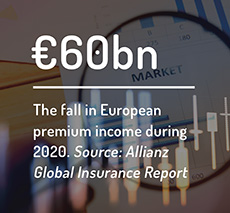Insurance companies are major investors in bonds – both by design and desire. Fiona Nicolson asks how insurers can find growth at a time when balance sheets have been hit by €60 billion in lost premiums.
Insurers are facing a perfect storm as income from premiums declines, while liabilities – including those related to Covid-19 and climate change – increase. In the UK, for example, the Association of British Insurers (ABI) said its members expected to pay up to £2.5 billion (€2.9 billion) for coronavirus-related insurance claims incurred in 2020, most of it related to business disruption.
Yet European insurers saw premiums fall by €60 billion last year, according to an Allianz Global Insurance Report.
Asset managers have launched or expanded their insurance asset management arms in recent years as they seek to give insurers the same kind of liability-matching service that they give to defined benefit pension schemes.
Tim Hooijdonk, an insurance specialist who is also Netherlands and UK country head for institutions at bond house Muzinich & Co, says: “We believe the main challenge is to deploy capital to investments that fit the liability profile of the insurance company and can provide a higher return in a low-yielding environment, with limited relative capital absorption.”
The low-yielding environment is an immense problem for insurers, whose assets are heavily dependent on bonds to offset liabilities.
As if that were not enough, Solvency II rules in the EU require insurers to pay a capital charge for assets they invest in. And the riskier the assets, the higher the charge – a fact that directs insurers to buy lower-risk bonds.
Last year, the European Insurance and Occupational Pensions Authority (EIOPA) proposed far-reaching changes to the Solvency II regulations, with implications for how insurers in the EU are funded and also governed.
 Insurers tend to look to the steady stream of returns generated by bonds to fund their liabilities. Figures from EIOPA last year showed that fixed income assets were almost two-thirds of portfolios, followed by equities (both listed and unlisted) at 15%. In the EIOPA ‘Opinion on the 2020 review of Solvency II’ published in December 2020, the organisation said: “Despite the negative yields experienced, insurers have continued to invest in negative or low-yielding bonds. Moreover, this pattern was further strengthened due to flight-to-quality investment behaviour observed during the Covid-19 situation.”
Insurers tend to look to the steady stream of returns generated by bonds to fund their liabilities. Figures from EIOPA last year showed that fixed income assets were almost two-thirds of portfolios, followed by equities (both listed and unlisted) at 15%. In the EIOPA ‘Opinion on the 2020 review of Solvency II’ published in December 2020, the organisation said: “Despite the negative yields experienced, insurers have continued to invest in negative or low-yielding bonds. Moreover, this pattern was further strengthened due to flight-to-quality investment behaviour observed during the Covid-19 situation.”
Erinn King, a managing director and insurance specialist at Payden & Rygel, which has £20 billion of insurance assets under management, says fixed income does remain a secure and safe haven for insurers.
“For insurance companies, bonds are always going to be in demand. They are the investment instrument that is the best complement to their liabilities and it’s also the most favoured in the regulatory framework.”
But what about growth? Can bonds help insurers here?
“There are a few areas where we’re seeing insurers look,” says King: “One is emerging market (EM) debt, where higher income is available at attractive capital charges. In addition, we are seeing select use of high yield and securitised bonds.
“While these come with a higher Solvency II capital charge, they can still play a role. You need to think about things holistically when looking at the total portfolio.”
The majority of property, casualty and health insurers are outsourcing their asset management, King says. The largest multi-line and life insurers have historically managed their assets in-house because they’re large enough to build a full team – “but even there, we’re seeing the outsourcing of speciality mandates like emerging market debt, securitised mandates, and private or alternative investments”, adds King.
A Cerulli Associates report last year found that European insurance assets outsourced to third-party, non-affiliated managers stood at around €1.2 trillion at the end of 2018 – slightly more than 16% of the region’s total general account assets.
The findings also suggested that outsourced assets were set to grow to more than €1.5 trillion, or around 19% of total assets, over the following five years.
The study highlighted that most insurance firms were “comfortable” managing core investment-grade fixed income in-house, but that insurers especially relied on outsourced expertise for overseas fixed income strategies, as well as certain income-generating alternative strategies.
Russell Lee, head of insurance solutions at fund manager M&G Investments, says: “Given where yields currently are on the more traditional asset classes that insurance companies tend to own – such as government bonds and investment-grade corporate debt – we are seeing increasing willingness for European insurers to invest more broadly across the markets.
“We have seen a few asset classes used to invest for growth. Private assets would certainly be one of them. A few others of note would be multi-asset credit, European loans, residential mortgages, high yield debt and EM debt.”
Climate risk
Lee adds that insurance companies’ outsourcing of portfolio management is a growing feature within the asset management market, but that asset managers having a specialist service is crucial for firms to be able to service and manage assets for insurers appropriately.
This would include a focus on climate change, which is impacting not only insurer balance sheets but also asset managers who need the right skill level to provide appropriate portfolio risk advice.
 The Network for Greening the Financial System – made up of 83 central banks and financial supervisors – noted in a 2019 report that worldwide economic costs from natural disasters had gone beyond the 30-year average of $140 billion (€118 billion) per annum in seven of the past ten years.
The Network for Greening the Financial System – made up of 83 central banks and financial supervisors – noted in a 2019 report that worldwide economic costs from natural disasters had gone beyond the 30-year average of $140 billion (€118 billion) per annum in seven of the past ten years.
Meanwhile, the International Association of Insurance Supervisors has urged insurers to consider their exposure to climate risks and to build resilience.
Lee says ESG considerations are among three “key factors” that are influencing the thinking of insurance clients. (The other two are increasing portfolio yield without ratcheting up risk levels, and a willingness to engage external asset managers).
King, at Payden & Rygel, also notes that insurers are ramping up the expertise in the area of ESG.
“Insurers are feeling pressure from shareholders to have robust ESG policies and we’re even seeing some insurers establish C-suite-type positions such as chief of ESG, whose role it is to influence ESG across all areas of the insurance company.”
Despite the increased focus on ESG, King also says: “Most importantly, insurers want to remain diversified, they want to be disciplined and they want to work with strong partners who can help them to shift course when the facts or the [investment] environment changes, because these inflection points are really important in terms of when is the right time to add incremental risk and when is the right time to pull back on the level of risk in the portfolio.”
Falling premiums
That environment has changed over the past year, for obvious reasons. In 2019, the global insurance industry experienced premium growth of 4.9%, with total premiums hitting a healthy €5 trillion, according to consultants McKinsey.
The Organisation for Economic Cooperation and Development’s 2021 report on global insurance market trends also noted a positive 2019. It said insurers benefited from a buoyant stock market and strong profits.
But the impact on the sector due to Covid-19 is then revealed in an Allianz Global Insurance Report, published in May this year. While the report showed that the industry had withstood the pandemic relatively well, it also found that global premium income had fallen by 2.1% in 2020 and life business had decreased by 4.1%. (Property insurance posted a slight uptick of 1.1%.)
The report also pointed to an overall decline steeper than that seen in the aftermath of the global financial crisis, with Western Europe feeling the worst effects. The region had the most pronounced drop in premiums – of 5.1% – last year.
Similar to the global picture, property managed to record a small increase, of 0.5%, but all in all, total premium income was down by close to €60 billion.
Economic recovery in Western Europe is expected to move at a slower pace than elsewhere, too, and Europe will also lag when it comes to premium levels. Globally, premium levels are anticipated to reach pre-crisis levels by the end of this year – but not in Europe, where the comeback year is estimated to be 2023.
Further evidence of the ravages the insurance sector has suffered come again from McKinsey, whose newer research published last year showed that the industry’s returns to shareholders since the beginning of 2020 and until month-end in October had dropped by 19%. What’s more, returns had slumped by as much as 23% in mid-June − an unprecedented drop in recent times and worse than some other sectors recorded.
Capital-charge focus
Inevitably, a growing level of liabilities from an increasing volume of claims has to be funded. And as King says: “We face a challenging environment today, which is forcing insurance companies to think about how they optimise the asset side of their balance sheet to establish diversified sources of investment returns.”
Not being too focused on the potential capital charge is key, however. King says: “We start from what’s the best economic portfolio given the macro environment we’re in today and what we see as the state of the world over the next six months. What we want to do is to build the best portfolio to meet the profile of the liabilities and earn an attractive return on behalf of the insurer’s balance sheet, and then optimise for Solvency II capital use.”
Looking to the future for the insurance industry, despite low interest rates, climate change and other challenges, the outlook seems more encouraging than of late, according to the Allianz report. It predicts strong growth for the industry this year, anticipating a 5.1% rise in premiums globally.
And the years ahead look promising too, as the report indicates a continuation of this growth, potentially at an average of more than 5% in the next ten years.
The drivers of this growth for insurance premium business are some of the same drivers that could drive insurance portfolios to gain higher returns – namely sustainability and emerging markets.
© 2021 funds europe





